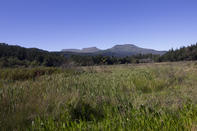Bilbo's Rain Frog

Bilbo's rain frog (Breviceps bagginsi) is named after the hero in J.R.R Tolkien's book - The Hobbit - that Dr Les Minter once read to his children. Not much is known about Bilbo's rain frog - science has only officially been aware of it for a few years - because most of its natural habitat has been lost to pine and gum plantations.
Today it is only found buried in the sandy soils of grassy road verges, which are probably the only places that resemble its original home. When it rains, Bilbo's rain frogs come out to sing. If you know what to listen for, you might pick up its song on the air somewhere on the roadside between Babanango and Melmoth, or near Howick.
Hogsback Frog

The Hogsback frog (Anhydrophryne rattrayi), or Rattray's forest frog, was first discovered in Hogsback by a school principal and has since been found at a few sites within the afromontane forests that hug the mountain slopes of the region. Its contribution to your listening pleasure would have been the melodious ping, ping, ping of the male calling for a mate. These tiny creatures - the female measures in at about 2 cm in length - reside in the leaf litter of the forest floor and dig nests for their eggs in the clay soil beneath it.
Most frogs need water to breed, which is why they break out in song when the rains come - something like a 'hurry, hurry, let's get to it before the weather clears!' The Hogsback frog is a little different. The tadpole is no water baby and would drown if it were dropped into a pond. It needs just enough moisture in its earthy home to grow from egg to tadpole to adult.
Endangered Frogs
Hogsback frog is listed as endangered because its habitat has been shaved away by commercial forestry and the steady felling of natural timber. Their communities have always been remote from each other, like villages scattered across a vast countryside. This makes them extremely vulnerable to any changes in their environment. If the forests here were to shift uphill, in keeping with the trend to escape climbing temperatures, would the Hogsback frog be able to move with them? Those forests that still have hills available to move up would probably find their migration cut off by farmlands, alien tree plantations, buildings and roads.
Another of Hogsback's endangered residents is the Amatola toad (Bufo amatolicus). Where the Hogsback frog settled into forests just above 1 100m in altitude, the toad prefers the moist grasslands higher up the mountains. But it has only been found at a few places on the Amatola and Winterberg Mountains, Hogsback being one of them. Its nasal squawk must once have been heard across kilometres of grassland on misty days before pine plantations spread out across the region. Now their grassy ponds are in a standoff with altered fire regimes and the sinking water table associated with these heat-burning, liquid-sapping trees.